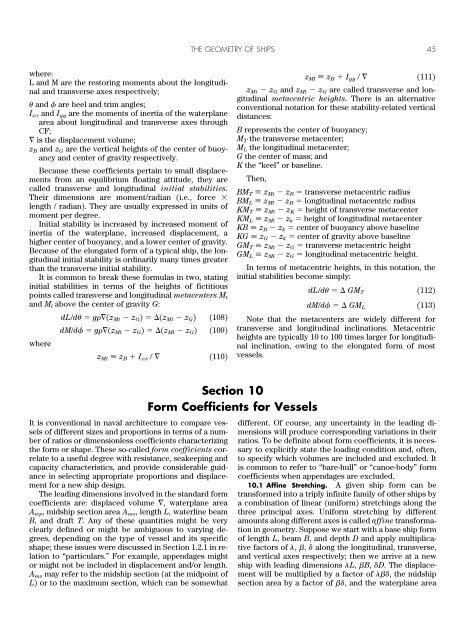The Geometry of Ships
You also want an ePaper? Increase the reach of your titles
YUMPU automatically turns print PDFs into web optimized ePapers that Google loves.
THE GEOMETRY OF SHIPS 45<br />
where:<br />
L and M are the restoring moments about the longitudinal<br />
and transverse axes respectively;<br />
and are heel and trim angles;<br />
I xx and I yy are the moments <strong>of</strong> inertia <strong>of</strong> the waterplane<br />
area about longitudinal and transverse axes through<br />
CF;<br />
is the displacement volume;<br />
z B and z G are the vertical heights <strong>of</strong> the center <strong>of</strong> buoyancy<br />
and center <strong>of</strong> gravity respectively.<br />
Because these coefficients pertain to small displacements<br />
from an equilibrium floating attitude, they are<br />
called transverse and longitudinal initial stabilities.<br />
<strong>The</strong>ir dimensions are moment/radian (i.e., force <br />
length / radian). <strong>The</strong>y are usually expressed in units <strong>of</strong><br />
moment per degree.<br />
Initial stability is increased by increased moment <strong>of</strong><br />
inertia <strong>of</strong> the waterplane, increased displacement, a<br />
higher center <strong>of</strong> buoyancy, and a lower center <strong>of</strong> gravity.<br />
Because <strong>of</strong> the elongated form <strong>of</strong> a typical ship, the longitudinal<br />
initial stability is ordinarily many times greater<br />
than the transverse initial stability.<br />
It is common to break these formulas in two, stating<br />
initial stabilities in terms <strong>of</strong> the heights <strong>of</strong> fictitious<br />
points called transverse and longitudinal metacenters M t<br />
and M l above the center <strong>of</strong> gravity G:<br />
dL/d g(z Mt z G ) (z Mt z G ) (108)<br />
dM/d g(z Ml z G ) (z Ml z G ) (109)<br />
where<br />
z Mt z B I xx / (110)<br />
z Ml z B I yy / (111)<br />
z Mt z G and z Ml z G are called transverse and longitudinal<br />
metacentric heights. <strong>The</strong>re is an alternative<br />
conventional notation for these stability-related vertical<br />
distances:<br />
B represents the center <strong>of</strong> buoyancy;<br />
M T the transverse metacenter;<br />
M L the longitudinal metacenter;<br />
G the center <strong>of</strong> mass; and<br />
K the “keel” or baseline.<br />
<strong>The</strong>n,<br />
BM T z Mt z B transverse metacentric radius<br />
BM L z Ml z B longitudinal metacentric radius<br />
KM T z Mt z K height <strong>of</strong> transverse metacenter<br />
KM L z Ml z k height <strong>of</strong> longitudinal metacenter<br />
KB z B z k center <strong>of</strong> buoyancy above baseline<br />
KG z G z k center <strong>of</strong> gravity above baseline<br />
GM T z Mt z G transverse metacentric height<br />
GM L z Ml z G longitudinal metacentric height.<br />
In terms <strong>of</strong> metacentric heights, in this notation, the<br />
initial stabilities become simply:<br />
dL/d GM T (112)<br />
dM/d GM L (113)<br />
Note that the metacenters are widely different for<br />
transverse and longitudinal inclinations. Metacentric<br />
heights are typically 10 to 100 times larger for longitudinal<br />
inclination, owing to the elongated form <strong>of</strong> most<br />
vessels.<br />
It is conventional in naval architecture to compare vessels<br />
<strong>of</strong> different sizes and proportions in terms <strong>of</strong> a number<br />
<strong>of</strong> ratios or dimensionless coefficients characterizing<br />
the form or shape. <strong>The</strong>se so-called form coefficients correlate<br />
to a useful degree with resistance, seakeeping and<br />
capacity characteristics, and provide considerable guidance<br />
in selecting appropriate proportions and displacement<br />
for a new ship design.<br />
<strong>The</strong> leading dimensions involved in the standard form<br />
coefficients are: displaced volume , waterplane area<br />
A wp , midship section area A ms , length L, waterline beam<br />
B, and draft T. Any <strong>of</strong> these quantities might be very<br />
clearly defined or might be ambiguous to varying degrees,<br />
depending on the type <strong>of</strong> vessel and its specific<br />
shape; these issues were discussed in Section 1.2.1 in relation<br />
to “particulars.” For example, appendages might<br />
or might not be included in displacement and/or length.<br />
A ms may refer to the midship section (at the midpoint <strong>of</strong><br />
L) or to the maximum section, which can be somewhat<br />
Section 10<br />
Form Coefficients for Vessels<br />
different. Of course, any uncertainty in the leading dimensions<br />
will produce corresponding variations in their<br />
ratios. To be definite about form coefficients, it is necessary<br />
to explicitly state the loading condition and, <strong>of</strong>ten,<br />
to specify which volumes are included and excluded. It<br />
is common to refer to “bare-hull” or “canoe-body” form<br />
coefficients when appendages are excluded.<br />
10.1 Affine Stretching. A given ship form can be<br />
transformed into a triply infinite family <strong>of</strong> other ships by<br />
a combination <strong>of</strong> linear (uniform) stretchings along the<br />
three principal axes. Uniform stretching by different<br />
amounts along different axes is called affine transformation<br />
in geometry. Suppose we start with a base ship form<br />
<strong>of</strong> length L, beam B, and depth D and apply multiplicative<br />
factors <strong>of</strong> , , along the longitudinal, transverse,<br />
and vertical axes respectively; then we arrive at a new<br />
ship with leading dimensions L, B, D. <strong>The</strong> displacement<br />
will be multiplied by a factor <strong>of</strong> , the midship<br />
section area by a factor <strong>of</strong> , and the waterplane area



